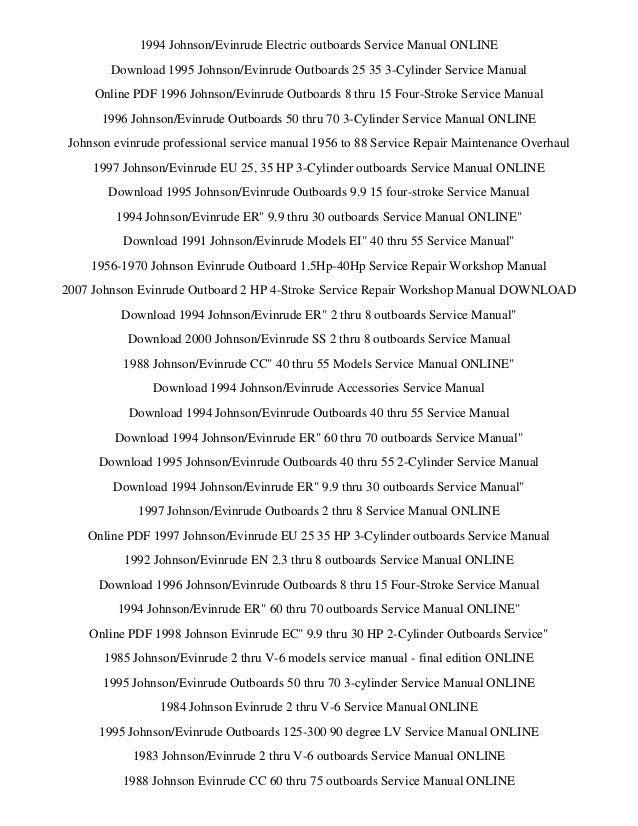- 1994 Johnson 15 Hp Outboard Manual Review
- 1990 Johnson 25 Hp Outboard
- 1994 Johnson 15 Hp Outboard Manual Briggs & Stratton
- 1994 Johnson 15 Hp Outboard Manual
johnson 9.9 outboard motor manual pdf service repair

This Repair Manual Covers: Safety Tuning Powerhead Fuel Ignition Electrical Accessories Lower unit Hand starter Maintenance Appendix.
LOW TENSION FLYWHEEL MAGNETO IGNITION SYSTEM 9.9 hp — 1974-76
1994 Johnson 15 Hp Outboard Manual Review
Workshop Manuals & Owner's Service Repair Manuals for Johnson & Evinrude Outboard Marine Engines For 2-Stroke, 4-Stroke Motors From 2-300 HP. 15 25 30 HP Repair. Johnson 13.15 HP Outboard Manuals return to top Year Model 1928 P-40 Johnson 13.3 HP Outboard Manuals return to top Year Model 1930-32 SA-50 SE-50 1933 S-65 1934 S-70 Johnson 15 HP Outboard Manuals return to top Year Model 1956 E-10 FD-10.
TYPE I1 CD FLYWHEEL MAGNETO IGNITION WITH SENSOR COIL 9.9 hp — 1977 & on
PROPELLER EXHAUST MECHANICAL SHIFT 9.9 HP 1974 & on
TYPE IV STARTER COIL SPRING WITH SLIDING GEAR HORIZONTAL MOUNT All 9.9 HP
Wire Identification – 9.9 hp and 15 hp with electric start – 1986 and on.
9.9 hp and 15 hp w/elec tr ic start — 1977-85
9.9 hp and 15 hp w/electric start — 1986 & on
Sections 8-9 and 8-10 — both lower units have propeller exhaust and use a sliding clutch dog. A detent ball and spring are used to hold the [mi t in the neutral position. The shift mechanism on the 9.9 hp and 15 hp models is forward of the forward gear, On the 35 hp model, the shift mechanism is just aft of the reverse gear.
1990 Johnson 25 Hp Outboard
In many cases, it is simply not enough to refer to a motor as a 9.9 hp model, since in these years JohnsonlEvinrude produced four different 2- cylinder motors with that rating (the 211cc Cstroke, the 216cc 2-stroke, the 255cc 2-stroke, and the 305cc 4-stroke). Across that same year span, Johnson Evinrude produced and sold no fewer than 4 different 2-stroke motors rated at 25hp (the 2-cylinder, 521cc, the 2-cylinder 737cc, the 3- cylinder 913cc and the 3-cylinder 933cc). This makes proper engine identification important for everything from ordering parts to even just using the procedures in this manual.
On some versions of 9.9115 hp (305cc), the timing belt is visible at one point in the manual starter cover. On most 819.9 hp (211cc) and 516 hp (128cc) motors, the belt is partially visible under the manual starter cover, but a thorough inspection is much easier once the manual starter cover and/or assembly is removed. For 70 hp (1298cc) motors, the flywheel cover must be removed to inspect the belt.
1. For safety when working around the flywheel, disconnect the negative battery cable andlor disconnect the leads from the spark plugs, then ground the leads on the powerhead.
2. Remove the manual starter assembly or the flywheel cover, as applicable, for better access to the timing belt.
3. Use low-pressure compressed air to blow debris out from under the camshaft pulley, flywheel and timing belt.
4. Visually check the belt for worn, cracked or oil soaked surfaces. Slowly rotate the flywheel (by hand) while inspecting all of the timing belt cogs.
5. Visually check the camshaft pulley and flywheel teeth for worn, cracked, chipped or otherwise damaged surfaces.
6. If the belt and or pulleys are damaged, replace them as described under Powerhead in this manual.
7. If removed, install the manual starter assembly or flywheel cover to the powerhead.
8. Install the spark plugs, then connect the leads followed by the negative battery cable and the engine cover.
For 9.9hp models, proceed as follows:

a. Remove the manual starter for access. On 216cc models, hold the starter pinion securely against the starter base to keep the recoil spring retained, then loosen the mounting screw and remove the assembly with the screw. Position the assembly on aide on 216cc models and install a 318-16 nut on the starter mounting screw.
b. For 216cc models, remove the low speed adjustment knob.
c. Loosen the 4 (216cc) or 2 (255cc) retaining screws and remove the air intake silencer cover. On 216cc models you’ll have to tilt the base in order to get it past the low speed needle.
d. Remove the choke knob detent and chock knob (216cc models) or the choke lever (255cc models).
e. Remove the cam follower screw and washer (216cc models) or cam follower O-ring (255cc models).
5/6 Hp (128cc) And 8/9.9 Hp (211cc) 4-Stroke Motors
516 Hp (128cc) and 8/9.9 Hp (211cc) 4-Stroke Motors
9.9/10/41/15 Hp (216cc), 9.9/10/15 Hp (255cc) and 18 JET-35 Hp (52lcc)Motors
819.9 Hp (211cc), 9.9-15 Hp (2161255~a~n) d 9.9115 Hp (305cc) Motors
819.9 Hp (211cc), 9.9-15 Hp (2161255~a~n) d 9.9115 Hp (305cc) Motors
1994 Johnson 15 Hp Outboard Manual Briggs & Stratton
Deluxe (87cc). 51618 Ho ( 1 6 4 ~ ~9).9.1 10114i15 HD (216cc). 9.9110115 Hp (255cc) and 18’jet-35 H~ (52lcc)’motors
1994 Johnson 15 Hp Outboard Manual
Starter circuit testing – 9.9/15 hp (305cc) 4-stroke tiller control models

Wiring Diagram – 1997-98 Tiller Electric 9.9 Hp (211cc) 2-Cylinderl4-Stroke Motors
Wiring Diagram – 1995-01 Rope Start 9.9115 Hp (305cc) 2-Cylinderlrl-Stroke Motors
Wiring Diagram – 1995-01 Tiller Electric 9.9 Hp (305cc) High Thrust 2-CylinderI4-Stroke Motors
Wiring Diagram – 1995 Remote Electric 9.9 Hp (305cc) High Thrust 2-Cylinderl4-Stroke Motors
Wiring Diagram – 1996-01 Remote Electric 9.9 Hp (305cc) High Thrust 2-Cylinderl4-Stroke Motors